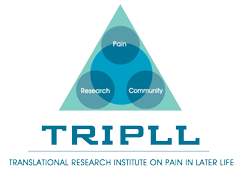Before TRIPLL there was CITRA. CITRA, short for the Cornell Institute for Translational Research on Aging, was a project funded by the National Institute on Aging (NIA) in October 2003. Like TRIPLL, CITRA sought to maintain strong ties with human service providers in New York City to increase the relevance and usefulness of their research. Over the last year of their grant, investigators brainstormed to determine the future direction of CITRA. The brainchild of their discussions was TRIPLL, which successfully allowed them to receive another five-year grant from the NIA in September 2009.
I sat down with Dr. Elaine Wethington, a principal investigator both at TRIPLL and CITRA to discuss how exactly this transition occurred.
TRIPLL: Hi, Dr. Wethington. I was hoping that you could explain the transition from TRIPLL to CITRA. How did you ultimately decide to focus on pain?
Dr. Wethington: We knew that pain was an issue important to community health and human service providers. Both CITRA based initiatives, the Persistent Pain Advisory Group and Chronic Pain in Older Persons, were launched with coalition by interested community agency heads and the community advisory committee. In addition, there was an interesting confluence of investigators who had approached CITRA for funding to study chronic pain. Because of this, focusing on pain seemed to fit into the theme of CITRA well. We were open to what investigators wanted to do, how they saw their role, and the way they viewed social isolation as a risk factor.
TRIPLL: Why did you think it was necessary to take a different direction from CITRA? Is there a specific reason why you didn’t apply for another grant with the same concept?
Dr. Wethington: CITRA was unusual among Roybal Centers not to have a specific disease focus. We had a rather broad description of who we were. In order to maximize our chances of being refunded and take advantage of the confluence of interests in chronic pain, we chose pain as the focus. We also felt that launching TRIPLL would increase our productivity by attracting more investigators since it seemed to be an issue important to many people. There were also inklings out of the NIA that they thought chronic pain was an interesting psychosocial issue. It seemed they were interested in discovering new ways of studying chronic pain and management and investigating the impact that pain has on senescence, morbidity, and quality of life.
TRIPLL: I know that at CITRA you focused a lot on social isolation and published “A Community-Based Participatory Critique of Social Isolation Intervention Research for Community-Dwelling Older Adults.” Could you talk about social isolation and its relationship to pain?
Dr. Wethington: Sure. Prevention of social isolation has always been an important, if not the most important topic, in social gerontology. Over time many people have thought about social isolation more as a risk factor for people who develop certain types of diseases that they are unable to cope with. This is even how we thought about it at CITRA. But, eventually we began to think of it in opposite terms and ask: what are the factors that increase social isolation? As pain progresses and people don’t get the intervention they need, they begin to participate less. Increased disability does not allow you to meet up and interact with friends. This leads to an increased feeling of being isolated from others and without a social network. Therefore, it is clear that pain prevention and management must play an integral part in the battle against social isolation.
